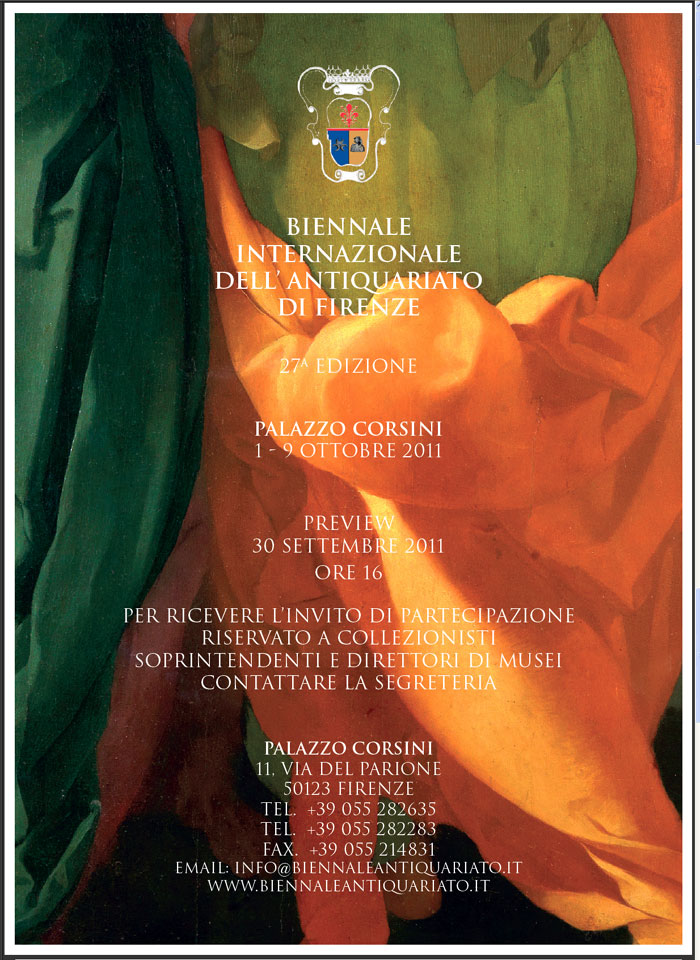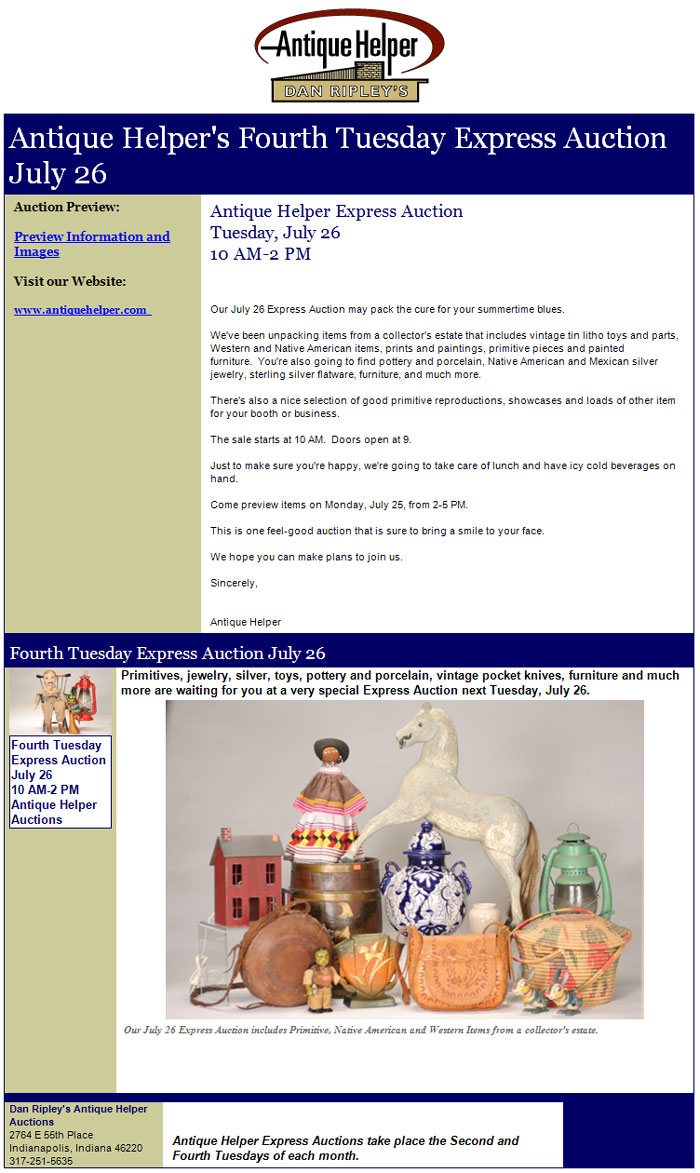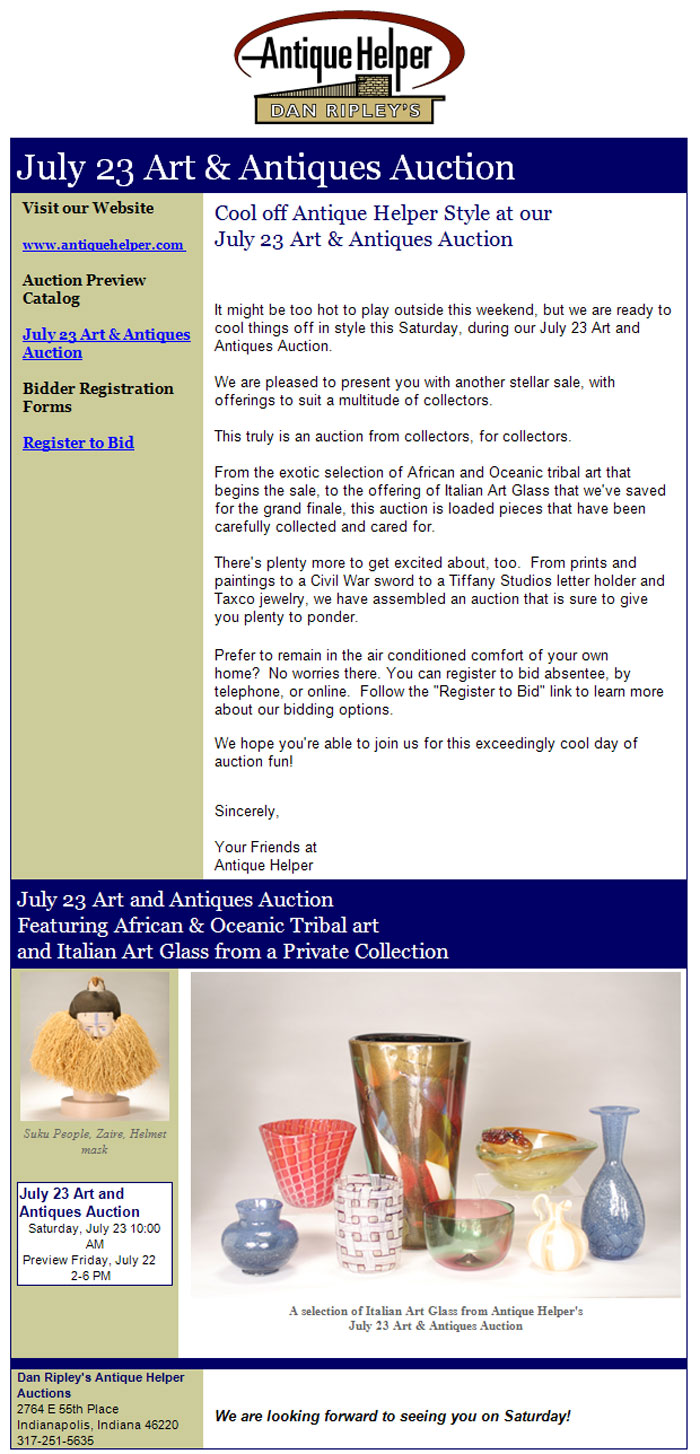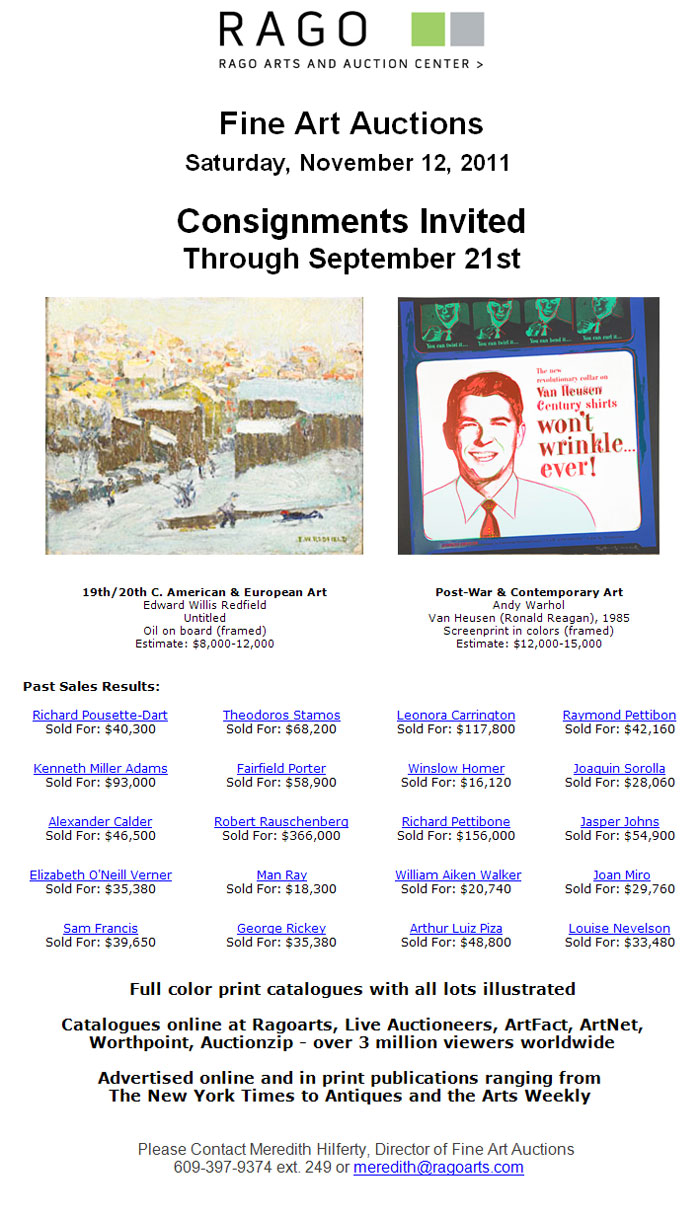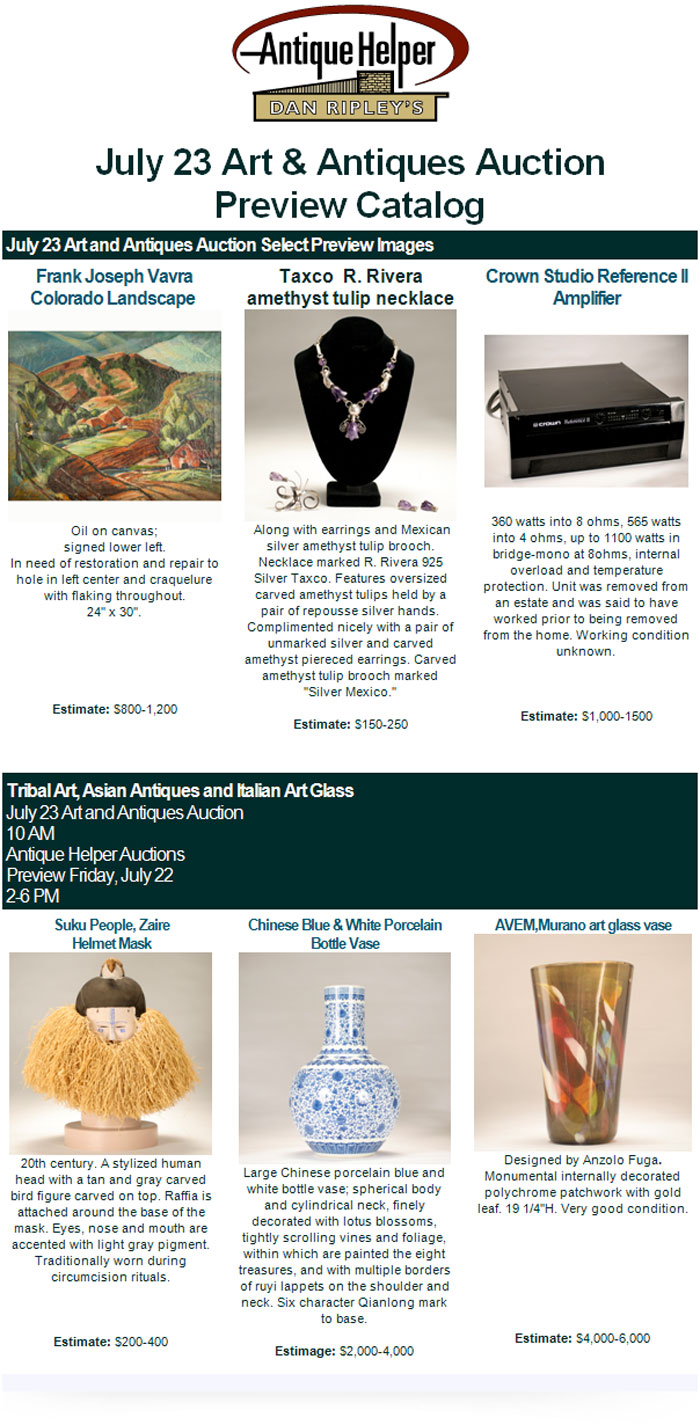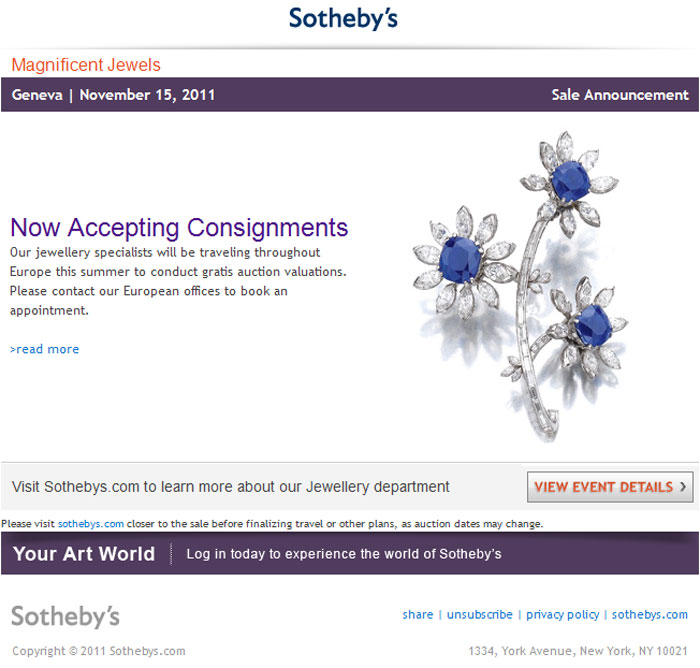Articles by admin
XXVII FLORENCE INTERNATIONAL ANTIQUES FAIR October 1-9, 2011 at the Palazzo Corsini
Tuesday, July 26th, 2011The 27th Florence International Antiques Fair (aka Florence Biennale) will be hosted this year at the enchanting Palazzo Corsini from October 1st– 9th with a layout masterminded by the Maestro Pier Luigi Pizzi. The Biennale, first started by Mario and Giuseppe Bellini in 1959, is the oldest continuous art and antiques fair in Europe and has become the most important Italian art exhibition in the world.
The home to the bi-yearly Florence Biennale since 1997, the Palazzo Corsini in its subdued Baroque style with an 18th-century flair is truly a unique and greatly admired building in Florence and a sight to see in itself. The residence, which was completed only in 1737, is also the proud home of Florence’s most important and historically significant private gallery, boasting a collection, begun in 1765 by Don Lorenzo Corsini, nephew of Pope Clement XII.
The works of art displayed by antiquarians from all over the world–74 Italian and 14 foreign—are the undisputed stars of the show. The vast variety of the over 3,000 pieces presented at the fair range from paintings to plates and antique books to sculptures.
All the works exhibited at the Biennale will be monitored and authenticated by the Scientific Committee. On September 28th, two Committees, the first appointed by the Florence Exports Office, and the second sent by the Ministry for the Cultural Heritage, will examine the works for which the antiquarians request a free circulation certificate, a document which allows Italian works of art to circulate abroad.
Collateral Events:
The Biennale continues to support Corri la Vita, an association, devoted to the study and prevention of breast cancer presided over by the Marchioness Bona Frescobaldi. On October 1st a charity evening will be held and during the dinner Christie’s will auction works of art donated by exhibitors at the Biennale. The proceeds of the auction will be devolved entirely in favour of the Association.
On October 5th prizes will be awarded to the best painting and sculpture at the Fair. The prizes, amounting to 10,000 Euro each, will be destined to the restoration of a work of art from the public cultural heritage.
On October 6th the “Lorenzo d’oro” prize will be awarded to Piero Angela, for his long and successful career as a director of documentaries.
Press Office:
Sveva Fede, tel. +39 336 693 367, tel. e fax +39 0575 370 368, sveva.fede@libero.it
Press Office for Tuscany:
Anna Pampaloni, tel. +39 055 69 63 65, +39 347 56 20 327, a.pampa@katamail.com
Foreign Press Offices:
Great Britain: Cawdell Douglas, 10-11 Lower John Street, W1R 3PE London (GB), tel. +44 207 439 28 22, fax +44 207 287 54 88, e-mail: press@cawdelldouglas.co.uk
U.S.A.: Jonathan Marder + Company, 24 Fifth Avenue, suite 1530, N.Y. 10011 New York (U.S.A.), tel. +1 646 638 24 79 fax + 1 646 638 25 29, e-mail: m.dattatreya@gsmltd.net
France: Colonnes, Claire Galimard, 16 rue des Saints-Pères, 75007 Paris (France), tel. +33 1 426 070 10, fax +33 1 426 070 07, e-mail: contact@colonnes.com
Info:
Expo Arte e Cultura S.r.l. – Via del Parione 11 – 50123 Firenze – tel. +39 055 282 283 – +39 055 282 635 – Fax +39 055 214 831 – www.biennaleantiquariato.it – info@biennaleantiquariato.it
Short history of the Florence International Antiques Fair
• The Mostra Internazionale dell’Antiquariato was launched in 1959 in the prestigious premises of Palazzo Strozzi. The Fair was the brainchild of Luigi Bellini Sr., designed to attract to Florence the very best in the international antiques world, and it made its name by offering the choicest selection in the collecting and antiques sector. The overwhelming success of the first Fair, and of those which followed, marked the start of a market season increasingly oriented towards the Antiques Fairs. The originality of the idea, accompanied by an astute selection of the antiquarians, transformed the Fair into a cultural and fashionable event that could not be missed, to the extent that the Florentine Fair was visited both by the members of the international jet set and by a crowd avid for curiosities, knowledge and marvels. The international triumph was triggered by the fact that it was held in Florence and was also accompanied for the entire duration by a series of highly attractive cultural and society events.
- Problems in the utilisation of Palazzo Strozzi, where adaptation work was being carried out, meant that in 1977 the antiquarians had to move to Palazzo Giuntini (now the Grand Hotel), after which they returned to the original site up to 1993. In 1987, Guido Bartolozzi took over from the Bellini brothers as the General Secretary.
- When Palazzo Strozzi became definitively unavailable in 1995 the Fair had to be moved to the Palazzo degli Affari, a fine building designed by Spadolini, but entirely unsuitable for an antiquarian fair of the level of the Florentine Biennale. For the following editions of the Fair, the choice fell on Palazzo Corsini sull’Arno, the current premises of the event, where it has been held since 1997.
• In 2001 the Management Committee appointed Giovanni Pratesi, Chairman of the Italian Antiquarians Association, as General Secretary of the Florentine Biennale. This appointment represented a crucial turning-point for the Fair and it was in fact in 2001, with an absolutely innovative design and the inclusion of numerous novelties in the general programme, that the Biennale set off on the path that has led to its being considered today as one of the three most important antiques events in the world.
• To place the Biennale at the level of the most prestigious international Fairs it was decided to promote strict controls on the works displayed, modify the image of the Fair by entrusting the orchestration to the Maestro Pier Luigi Pizzi, who performed an authentic masterpiece of restyling, introducing a new pavilion in the entrance courtyard of the Palazzo, boost promotion by setting up specialised Press Offices in the major cities of the world (Wiesbaden, London, Paris, New York); extend to the Italian exhibitors the same rights as their foreign counterparts, offering them advance examination of the works on display so as to provide them with export licences before the start of the Fair.
THE CORSINI PALACE
Maria Maddalena Machiavelli, wife of Marchese Filippo Corsini, purchased the Palace from the Grand Duke Ferdinando II in 1649. Her son, Bartolomeo, began remodelling and redecorating the Palace in 1650. Initially the work was done by Alfonso Parigi the Younger, and then by Ferdinando Tacca, who continued with the project until 1671. Actual construction work on the Palace as it stands today was commissioned by Filippo Corsini junior, in 1685, after the death of his father Bartolomeo. Construction was directed by Antonio Ferri, a versatile exponent of the late Baroque Florentine culture. He was a set designer and engineer, who built machines and fortifications and than poured his extraordinary elegance and creative skill into Palazzo Corsini, making it one of Florence most unusually luxurious palaces.
The decorations, executed between 1692 and 1700, are among the finest examples of Florentine painting. Among the artists the Corsini family commissioned to decorate the located, we must mention the outstanding maters Anton Domenico Gabbiani, Alessandro Gherardini and Pier Dandini.
Palazzo Corsini, located on the banks of the Arno river, is in the heart of Florence, just a short walk from the Ponte Vecchio and the Duomo and near the smart Via Tornabuoni.
The Salon and the Aurora Gallery
When the Salon in the Palazzo Corsini was inaugurated in the late seventeenth century, Antonio Ferri’s designs (1694‑1696) must have aroused widespread amazement. Entering the room from the grand staircase, which forces a corner view, is an enormous source of wonder. The visitor sees an extraordinary room flooded with light reflected from the walls with their columns, bases and rippling cornice. The ceiling in the Salon is decorated with a glorification of the Corsini family, and it supports two gigantic painted wooden chandeliers that were carved by Antonio Francesco Gonelli between 1698 and 1700. The doors of the Salon open onto the adjacent decorated rooms.
Size and prestigious location make this splendid salon one of the most sought after reception rooms in the heart of Florence.
The impressive main staircase leads to the Aurora Gallery which is part of the main building: its large, arched windows look onto the courtyard and offer a splendid view of hills on the opposite side of the Arno river.
This luminous and completely frescoed gallery was decorated by Bartolomeo Neri and Alessandro Rosi, and with the other luxurious rooms of Palazzo Corsini, will house, from the 30th September to the 9th October, the 24th edition of the International Antique Fair.
The Ballroom
The Ballroom, that overlooks an internal courtyard, is reached via the middle door (on the left) of the Salon. The large crystal chandelier and the gilded eighteenth century wall sconces complete the decorations.
The fresco, painted by Alessandro Gherardini between 1695 and 1696 is set in a plasterwork frame enhanced with flowers and two scrolls. In the middle of the composition in Aurora’s chariot drawn by Pegasus. The goddess of dawn, sister of Helios, the sun god, is surrounded by three maidens, the Hours, one of whom is holding a floral crown, while a Putto holding a torch, symbol of the goddess, precedes the chariot. On one edge of the fresco, Gherardini painted the Kingdom of Flora, with Zephyr, the young god with butterfly wings and some nymphs accompanying the goddess. On the opposite side is the Triumph of Galatea: the sea nymph is on a shell drawn by dolphins, and Polyphemus with his heard is in front of her, playing a love song on his pipe. The care the artist dedicated to the fresco is the further enhanced by the decorative elements he added: four vases in the corners of the arch; those near the Kingdom of Flora are decorated with garlands of flowers, the other two with sea creature and fish. It can be easily said that this fresco is the finest decorative work in the entire Palace.
During the Antiques Fair, the padded and lined with precious silk seats will be removed to protect their integrity.
Dan Ripley’s Auction Helper – Express Auction
Monday, July 25th, 2011NATIVE AMERICAN: Clothing, costumes, headdress, suede, jewelry, drums, beaded objects, pottery, shoes, baskets, rawhide pouches, Hudson Bay jackets, fur trapper coats WESTERN: Ghost Riders Western canvas barn jackets, canteens, chaps POTTERY AND PORCELAIN: Lenox lamp, Rookwood, Johnson Brothers, Occupied Japan, Copeland Spode, Roseville, Mexican pottery, Goldscheider porcelain figures PRIMITIVE: birdhouses, Washer wringer, butter churn, buckboard bench, framed barbed wire samples FURNITURE: Pennsylvania Dutch trunk, glass-top display coffee table, Chinese red lacquer cabinet, Victorian carved chairs, piano stool, painted nightstand, folk art furniture, child’s rocker, contemporary curio, industrial coffee table on castors, patriotic painted dresser, folk art painted trunk, lady’s writing desk PRINTS & PAINTINGS: Western & Native American Artwork, STERLING FLATWARE: 19 Sterling Reed & Barton Marlborough pattern teaspooons & knives TOYS: Renwal shipyard, Marx Disneyland trains, ventriloquist dummy, tin litho toys, dolls & doll clothes, rocking horse, doll houses, N. H. Hill Brass Co. pull toy, Lone Ranger knives MISC: Canteens, Bradford Exchange, Michael Jordan uniform, oil lanterns, train lantern, American flag, books, pocket knives, Champleve lamp, Murano studio art glass, lucite display cases, postage stamp collection, black Americana
Sotheby’s London – Material Worlds
Monday, July 25th, 2011Sotheby’s is delighted to announce an exclusive collection of leading designers and artists for MATERIAL WORLDS, its second outdoor selling exhibition in collaboration with Sudeley Castle, from 28 July to 30 September 2011. The exhibition brings together cutting-edge, one-off and limited edition works in strikingly different materials by 11 artists and designers, including Tord Boontje, Amanda Levete, David Adjaye, Ingo Maurer and Paul Fryer. Set amongst the romantic ruins of Sudeley and its award-winning gardens, the works will challenge the boundaries of Design, Art and Craft.
Dan Ripley’s Antique Helper
Thursday, July 21st, 2011Rago Arts and Auction Center – Fine Art Auction
Thursday, July 21st, 2011Morphy Auctions opens sports memorabilia department
Wednesday, July 20th, 2011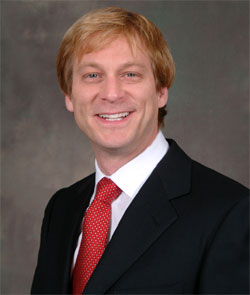
Tom Sage Jr., chief operating officer of Morphy Auctions and head of the company’s new sports memorabilia department. Morphy Auctions image.
DENVER, Pa. – Morphy Auctions’ CEO Dan Morphy has announced the addition of a full-service sports memorabilia department to his company’s growing roster of specialty divisions. The new department is supervised by Morphy’s chief operation officer Tom Sage Jr.
“We decided to open a sports department because of the increasing number of requests from collectors who wanted to consign their collections and game-used items,” said Sage. “We’ve incorporated sports memorabilia into our general and toy sales regularly over the past six or seven years, and we’ve also referred business to companies that specifically handle sports memorabilia, but we reached a point where there were so many inquiries, it was clearly time to start holding our own specialty sales.”
The plan is to conduct dedicated semiannual auctions of items from all major sports, including football, baseball, basketball, hockey, boxing, golf and more. In particular, Morphy’s sports sales will focus on Major League and collegiate game-used jerseys and other apparel; sports equipment, rings and jewelry; photographs and ephemera; and other quality collectibles with a connection to professional athletes.
Sage, a lifelong antique dealer and collector who began his career selling baseball cards in 1977, said a strong emphasis will be placed on provenance and authentication. “Buyers expect, and will receive, letters or certificates of authenticity when they buy game-used or autographed items from Morphy’s. We will be using the services of some of the sports memorabilia industry’s top authenticators in vetting the merchandise we sell.”
Morphy’s debut auction of sports memorabilia will take place this fall, with another sale to follow in spring of 2012. Consignments are currently being accepted. Call Tom Sage at 717-335-4571 or e-mail tom@morphyauctions.com.
Sotheby’s – London – Fine Furniture including Rugs and Tapestries
Wednesday, July 20th, 2011Dan Ripley’s Antique Helper – Auction Preview
Tuesday, July 19th, 2011Sotheby’s – Geneva – Magnificent Jewels
Tuesday, July 19th, 2011In advance of our forthcoming sale in November, our jewellery specialists are currently travelling throughout Europe to conduct confidential and complimentary auction valuations and to offer advice about buying and selling. Please contact our European offices to make an appointment:
Geneva: +41 (0) 22 908 48 49
London: +44 (0)20 7293 6409
Paris: +33 1 53 05 53 37
Milan: +39 2 2950 0201
Monaco: + 37 793 30 88 80
Zurich: +41 44 226 22 71
Madrid: +34 91 576 5714
Barcelona: +34 93 414 0866
Brussels: +32 2 648 0080

